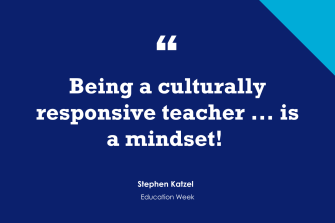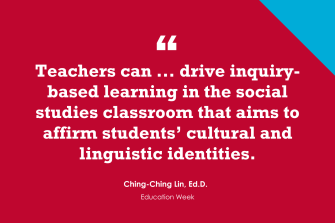(This is the final post in a three-part series. You can see Part One here and Part Two here.)
The new question of the week is:
What are your suggestions for how to make social studies classes culturally responsive?
In Part One, Denise Facey, Sarah Cooper, Dennisha Murf, and Keisha Rembert “kicked” things off.
Denise, Sarah, Dennisha, and Keisha were also guests on my 10-minute BAM! Radio Show. You can also find a list of, and links to, previous shows here.
In Part Two, Don Vu, Kiera Beddes, and Stephanie Smith Budhai, Ph.D., contributed their reflections.
Today, Stephen Katzel and Ching-Ching Lin, Ed. D. wrap-up this series.
‘Not a Singular Lesson’
Stephen Katzel is the author behind Win Your First Year of Teaching Middle School: Strategies and Tools for Success. He is an educator with a passion for middle school education and helping new teachers:
For decades, differing opinions have existed on how to teach social studies, with no national consistency, meaning that a child in Boston may receive an entirely different perspective from another in Boise, Idaho. Social studies has dominated the headlines educationally and politically due to parent’s perceptions on the correct way to teach and implement the curriculum in the classroom.
To drown out the political banter and farcical politicians, social studies teachers must adopt a specific approach on culturally responsive teaching. Which isn’t a lesson, a picture, or a reading, but a mindset. It doesn’t matter if you are teaching world history, U.S. history, or any class related to social studies, your mindset that each lesson will be culturally responsive is crucial for engagement and achievement.
Adopting a mindset of cultural responsiveness will pay dividends for your students and content. Each day, social studies teachers can post “Today in History” on the board that lists historically significant events or achievements about a person or group of people. Teachers can access dozens of pre-made, culturally relevant lists online that resonate to different groups of students. The “Today in History” ideally would be related to the content you are covering in class, but if not, no problem! Highlighting accomplishments from different cultures and groups of people will make students feel supported, seen, and appreciated. In addition, teachers can use the “Today in History” as a hook to begin their lesson on the historical content covered in class that day.
Knowing the primary and secondary sources being used is critical for increasing cultural responsiveness in social studies classes. Many social studies curriculums completely exclude the perspectives of marginalized historical figures and groups. Spending class time analyzing differing perspectives and historical figures will increase cultural responsiveness and add depth to any social studies lesson due to additional voices being added to the historical content being covered in class. Next time you prepare a lesson that involves primary sources, I challenge you to add an extra source that highlights and amplifies the voice of a person or group not traditionally included in the curriculum that you teach.
Teaching social studies comes with a great deal of responsibility and trust. Making a concerted effort to include different sources and viewpoints in your daily routines and lessons will not only enrich your classroom, but also the lives of the students that you teach. Remember, being a culturally responsive teacher is not a singular lesson, it is a mindset!

‘Beyond SIOP’
Ching-Ching Lin, Ed.D. is a former social studies and ESL teacher and is currently a teacher educator in TESOL and Bilingual Education in New York City. She is a co-editor and contributing author of the following edited volumes, Internationalization in Action: Leveraging Diversity and Inclusion in Globalized Classrooms and Inclusion, Diversity, and Intercultural Dialogue in Young People’s Philosophical Inquiry:
ESL teachers tend to see our job in social studies or other content area classrooms as providing language support, building fluency, vocabulary, and comprehension skills in content areas. We help learners develop the skills necessary for academic success and expand their access to the general education curriculum.
Essentially, the above-mentioned classroom practices imply that students cannot meaningfully interact with the text until they have understood the distinctive text features of what they read or hear. Such views not only treat reading and writing as context-independent skills, but also reflect an oversimplified, linear view of language acquisition that often leads to missed opportunities to engage multilingual learners’ complex literacy practices and agency.
In contrast, an asset-based lens would look at students positively, assessing what they bring with them as strengths and embracing these strengths. What if, instead of approaching students based upon our perceptions of their weaknesses, we purposefully position ourselves as a co-learner, questing, connecting, probing, deeply curious, focusing on students’ strengths and empowering them as creators of knowledge?
Here are a few suggestions to infuse asset-based approaches into a fifth grade SIOP (Sheltered Instruction Observation Protocol) lesson for English-language learners about the Dust Bowl to move our goals beyond providing language support in the social studies classroom.
By connecting students to their local community, teachers can use their power of understanding, curiosity, and empathy to drive inquiry-based learning in the social studies classroom that aims to affirm students’ cultural and linguistic identities.

Thanks to Stephen and Ching-Ching for contributing their thoughts!
Consider contributing a question to be answered in a future post. You can send one to me at lferlazzo@educationweek.org. When you send it in, let me know if I can use your real name if it’s selected or if you’d prefer remaining anonymous and have a pseudonym in mind.
You can also contact me on Twitter at @Larryferlazzo.
Education Week has published a collection of posts from this blog, along with new material, in an e-book form. It’s titled Classroom Management Q&As: Expert Strategies for Teaching.
Just a reminder; you can subscribe and receive updates from this blog via email (The RSS feed for this blog, and for all EdWeek articles, has been changed by the new redesign—new ones are not yet available). And if you missed any of the highlights from the first 11 years of this blog, you can see a categorized list below.
- It Was Another Busy School Year. What Resonated for You?
- How to Best Address Race and Racism in the Classroom
- Schools Just Let Out, But What Are the Best Ways to Begin the Coming Year?
- Classroom Management Starts With Student Engagement
- Teacher Takeaways From the Pandemic: What’s Worked? What Hasn’t?
- The School Year Has Ended. What Are Some Lessons to Close Out Next Year?
- Student Motivation and Social-Emotional Learning Present Challenges. Here’s How to Help
- How to Challenge Normative Gender Culture to Support All Students
- What Students Like (and Don’t Like) About School
- Technology Is the Tool, Not the Teacher
- How to Make Parent Engagement Meaningful
- Teaching Social Studies Isn’t for the Faint of Heart
- Differentiated Instruction Doesn’t Need to Be a Heavy Lift
- How to Help Students Embrace Reading. Educators Weigh In
- 10 Strategies for Reaching English-Learners
- 10 Ways to Include Teachers in Important Policy Decisions
- 10 Teacher-Proofed Strategies for Improving Math Instruction
- Give Students a Role in Their Education
- Are There Better Ways Than Standardized Tests to Assess Students? Educators Think So
- How to Meet the Challenges of Teaching Science
- If I’d Only Known. Veteran Teachers Offer Advice for Beginners
- Writing Well Means Rewriting, Rewriting, Rewriting
- Christopher Emdin, Gholdy Muhammad, and More Education Authors Offer Insights to the Field
- How to Build Inclusive Classrooms
- What Science Can Teach Us About Learning
- The Best Ways for Administrators to Demonstrate Leadership
- Listen Up: Give Teachers a Voice in What Happens in Their Schools
- 10 Ways to Build a Healthier Classroom
- Educators Weigh In on Implementing the Common Core, Even Now
- What’s the Best Professional-Development Advice? Teachers and Students Have Their Say
- Plenty of Instructional Strategies Are Out There. Here’s What Works Best for Your Students
- How to Avoid Making Mistakes in the Classroom
- Looking for Ways to Organize Your Classroom? Try Out These Tips
- Want Insight Into Schooling? Here’s Advice From Some Top Experts
I am also creating a Twitter list including all contributors to this column.







